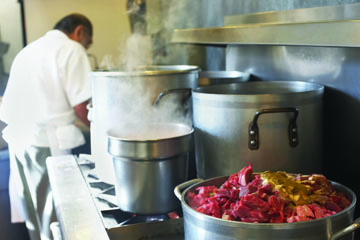Eva Langley
Pike County Extension Agent
Family & Consumer Sciences
Cooking at home is one way to plan and keep track of calories, portion sizes, and nutrients. Since you can see the ingredients, you know EXACTLY what is in each serving you eat—a great advantage to cooking your own food—nothing is HIDDEN. Unfortunately, many people avoid cooking at home either because they feel that their cooking skills aren’t up to par, don’t have the time, or prefer the taste and quality of meals eaten out. Or maybe they just don’t like to cook – yet. This doesn’t have to be the case! Pike County Extension will be offering Mediterranean Cooking School classes in January. Classes will be held on two evenings, covering both Western and Eastern Mediterranean recipes. Come ready for lots of laughter, lots of flavor, and lots of hands on cooking experience. Each night will be filled with words like Tapenade, Koshari, Rouille, Tabbouleh, Focaccia, and Risotto. Your recipe book for each evening includes a photo of each dish and a pronunciation guide for easy reference back in your own kitchen.
The Mediterranean diet is a lifestyle approach to healthy eating that includes a balanced variety of foods and daily exercise. It is characterized by plant foods including fruits, vegetables, whole grains, legumes, beans and nuts and uses olive oil as the primary source of fat. But don’t worry there are recipes that include, meats, cheese, and seafood too. This way of eating is not only healthy but tasty! Research has shown that following a Mediterranean-type diet can reduce blood pressure, blood cholesterol, triglycerides and blood sugar levels; increase HDL cholesterol; improve the total cholesterol/ HDL cholesterol ratio; reduce inflammation; and decrease insulin resistance.
Generally the Mediterranean diet relies on fresh rather than processed foods. It is lower in saturated fats, salt and sugar. It is rich in plant foods including fruits, vegetables, whole grains, legumes, beans and nuts. Olive oil is the primary source of fat. Cheese, yogurt, fish, poultry and eggs are eaten in low to moderate amounts. Only a small amount of red meat is consumed. Wine is included with meals in moderation. The traditional Mediterranean diet consists of minimally processed, seasonally fresh, locally grown grains, vegetables, fruits and nuts which are eaten at most meals. These foods are important sources of vitamins, minerals, fiber, and antioxidants. Soluble fiber slows the rate of digestion helping keep blood glucose in check. While following a Mediterranean diet does not guarantee better health and increased lifespan, scientists believe that for many people it is a cost-effective way to improve health and prevent chronic disease.
In addition to the nutritional benefits of this way of cooking and eating, there are other lifestyle aspects included in the Mediterranean experience that are important to our overall health. These include making meal times a social event with friends and family, being physically active on a daily basis, and limiting portion size as we enjoy good foods that are good for us. So, “Pull up a chair, take a taste, come join us. Life is so endlessly delicious.” This cooking school would be a great Christmas present for a couple, best friends, or family members. If you would like to put a Pike County Mediterranean Cooking School Gift Certificate in a Christmas stocking or under the tree, give us a call at 870-285-2161. Each night is $30 per night for a total of $60 per person. Here is one of the recipes featured in the Eastern Mediterranean class. Enjoy!
Recipe of the Week: Greek Yogurt Panna Cotta with Honey Glazed Apricots
Ingredients:
2 envelopes (4½ teaspoons) gelatin
4 Tablespoons cold water
2 cups heavy cream
⅔ cup sugar, granulated
2 Tablespoons vanilla paste* (can substitute pure vanilla extract)
36 ounce Greek yogurt, plain nonfat
2 cups apricots, dried**
2 cups semi-dry white wine
½ cup honey
*Can purchase from restaurant supply store.
**Can substitute other fruit. Fresh blueberries work well. If substituting fresh fruit, use less wine.
Directions:
1. In a small bowl, sprinkle the gelatin over the cold water; let stand until softened, 5 minutes.
2. In a saucepan, bring the cream, sugar and vanilla paste to a simmer. Turn off the heat, stir in the gelatin until melted.
3. In a bowl, whisk the yogurt until smooth. Gradually, whisk in the vanilla cream.
4. Pour the mixture into 12 ½-cup ramekins and refrigerate until set, at least 3 hours.
5. Meanwhile in a saucepan, simmer the apricots in the white wine over moderately low heat until the apricots are plump and the wine has reduced by half, about 20 minutes.
6. Stir in the honey and simmer the syrup until thickened, about 5 minutes; let cool.
7. Run a knife around the inside of each ramekin. Set a plate in each ramekin and invert each panna cotta onto a plate; you may have to tap and shake the ramekins to loosen the panna cottas.
8. Slice the apricots and spoon them on top of the panna cottas. Drizzle with some of the honey syrup and serve.
The Arkansas Cooperative Extension Service offers its programs to all eligible persons regardless of race, color, sex, gender identity, sexual orientation, national origin, religion, age, disability, marital or veteran status, genetic information, or any other legally protected status, and is an Affirmative Action/Equal Opportunity Employer.







